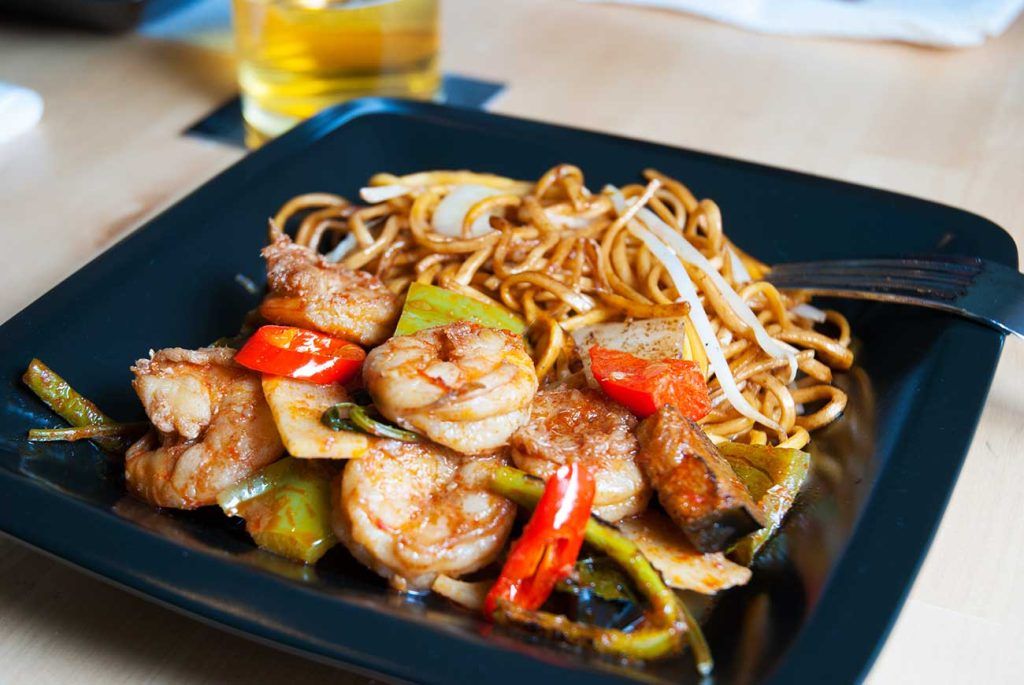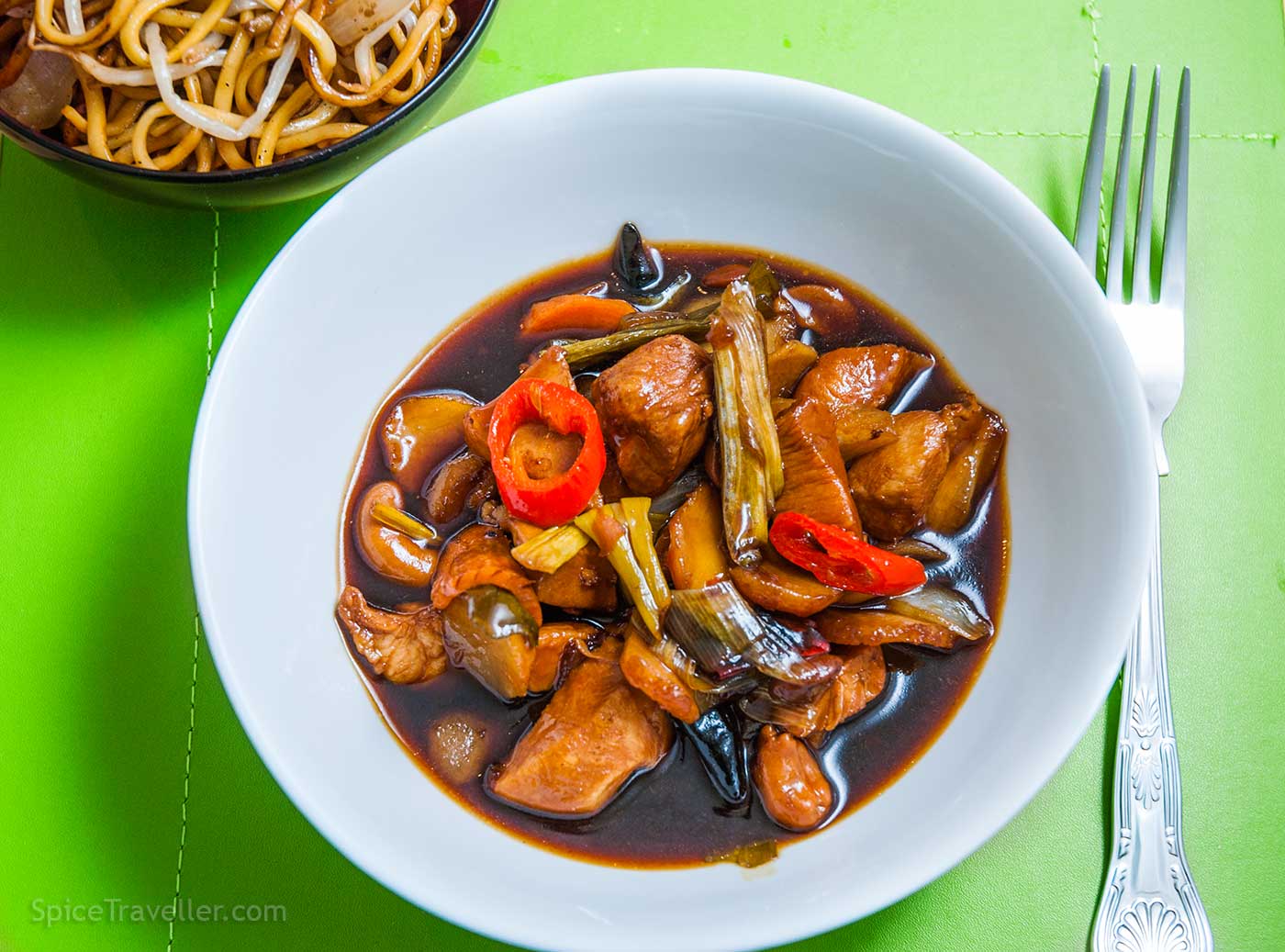This Jungle curry is a dark, spicy Thai dish with chicken, dried mushrooms, and fresh chillies, cooked in a thin, coconut-free broth scented with herbs and spices.
About this recipe
Origins
Jungle curry, or kaeng pa, comes from the forested north of Thailand, where coconuts were historically scarce. Unlike most Thai curries, it contains no coconut milk, resulting in a thin, pungent broth. Originally made with wild game and foraged herbs, it delivers intense heat and a sharp, herbaceous flavour from ingredients like lemongrass, chillies, and shrimp paste.
Tradition
Today, Jungle curry is typically made with pork, chicken, or fish rather than wild meat, but it still relies on a strong foundation of fresh herbs, dried chillies, and fermented ingredients like shrimp paste and fish sauce. Thai aubergine/eggplant, green beans, and bamboo shoots are common ingredients. The dish is usually served with steamed rice, and it is one of the spiciest and quickest Thai curries to prepare.
This Recipe
This version sticks to the basics of a traditional jungle curry – no coconut milk, a homemade paste of chillies, lemongrass, shrimp paste, and a thin, spicy broth, but uses ingredients that are easier to find outside Thailand.
I swapped ginger for galangal, and used plain aubergine instead of Thai mini aubergines, which are hard to find. I also added dried mushrooms and some optional carrot and bell pepper for extra texture and colour.
It’s a seriously spicy curry, but you can easily control the heat by using less fresh chilli if you prefer.
Thai Jungle Chicken Curry Ingredients
Note
Some Thai ingredients like holy basil, Thai aubergine, kaffir lime leaves, shrimp paste and galangal are difficult to find outside Thailand.
To keep the flavour true, I have used fresh ginger in place of galangal, and lime zest in place of kaffir lime leaves. I also included shitake mushrooms, carrots and bell peppers for added texture and colour, although they are not part of the traditional version.
Curry Paste Ingredients:
- ginger – Fresh ginger is a practical substitute for traditional galangal, traditionally used in Thai curry pastes; it gives a similar warmth, but galangal has a sharper, more citrusy edge.
- chillies – Use fresh Thai red chillies, or another medium to hot variety.
- lemongrass – Use only the lower white part of the stalk; trim and cut into pieces
- onion – Yellow onion gives the best flavour.
- garlic – Fresh cloves, not jarred or paste, for a stronger aroma
- ground coriander – Use standard ground coriander
- shrimp paste – Look for Thai brands. If shrimp paste is unavailable, use a small amount of miso paste; this adds savoury depth.
- fish sauce – Choose a high-quality Thai brand. Fish sauce is crucial for building the right flavour in Thai dishes. I don’t recommend any substitute, because without it, the curry loses the authentic taste Thai food is known for.
Main Ingredients:
- chicken – Use boneless thighs for the best flavour.
- aubergine (eggplant) – Use regular aubergine if Thai mini aubergines are not available.
- bamboo shoots – Buy jarred or canned bamboo shoots. Drain well before using.
- dried mushrooms – Shiitake works well; soak in hot water before using.
- onion – Use yellow onion, best for curry base.
- carrot (optional) – Thinly sliced or julienned, adds colour and texture.
- bell pepper (optional) – Use red or yellow for sweetness, green for a sharper taste.
- red chillies – Use fresh Thai red chillies for heat, or adjust to taste with a milder variety.
- lemongrass – Use whole bruised stalks to flavour the broth; remove before serving.
- fish sauce – Essential for seasoning and depth of flavour; no substitute recommended.
- sugar – Balances the heat and saltiness slightly; use brown sugar.
- cashew nuts (optional) – Not traditional, but adds a good texture contrast.
- chicken stock (optional) – Use a cube or powdered stock dissolved in water.
A little soy sauce can be added for extra flavour, although it isn’t a traditional ingredient.
Craving more heat? 🌶️ Explore other bold and spicy international recipes:
Simple Spinach with Chilli and Shrimp Paste (Kangkung Belacan) 🇲🇾
Simple Sweet and Spicy Caribbean-style Brown Chicken Stew 🏝️
How to make modern-style Thai Jungle Chicken Curry
- Crush all the curry paste ingredients using a mortar and pestle, or blend them finely in a small food processor.
- Warm a little oil in a wok or deep frying pan over a medium heat. Add the curry paste and fry for about 2 minutes until fragrant.
- Meanwhile, soak the dried mushrooms in 200 ml of hot water for 10–15 minutes until softened.
- Prepare ingredients: Cut the chicken into small pieces or strips. Cut the onion into large chunks, and slice the carrot thinly. Cut the aubergine and pepper into small pieces.
- Add the chicken and onion to the wok and stir well to coat the meat in the paste. Fry for 5 minutes until the chicken is lightly browned and the onion begins to soften.
- Pour in the chicken stock or water, followed by the soaked mushrooms, carrot, pepper, aubergine, bamboo shoots, fresh chillies and the bruised lemongrass stalk. Bruise the lemongrass stalk before adding to release its aromatic oils. Stir in the fish sauce and brown sugar.
- Bring to a gentle simmer. Cook for around 15 minutes, stirring occasionally, until the chicken and vegetables are just tender. Taste near the end of cooking and adjust the seasoning if needed, as the broth becomes saltier as it reduces.
Traditionally, jungle curry is fairly watery like a soup, and is eaten with a spoon.
However, you can simmer it for longer if you prefer a thicker consistency.
Serving Thai Jungle Curry
Serve the jungle curry hot with steamed jasmine rice, plain noodles, or fried noodles to soak up the spicy broth. Traditionally, it is eaten with a spoon due to its thin, soup-like consistency.
I served it with simple fried noodles, but any plain rice or noodle dish works well.
I’ve also made this jungle curry with prawns instead of chicken, served with fried noodles for a lighter, spicier version.

Full Recipe

Modern-style Thai Jungle Chicken Curry
Ingredients
CURRY PASTE
- 1 piece ginger
- 2 red chillies
- 2 lemongrass - only white part
- 1/2 onion
- 3 garlic cloves
- 1 tsp ground coriander
- 1/2 tsp freshly ground pepper
- 1 tsp shrimp paste
- 1 tsp fish sauce
MAIN INGREDIENTS
- 500 g boneless chicken thighs
- 1 cup dried mushrooms
- 1 carrot
- 1 bell pepper
- 200 g bamboo shoots
- 1/2 onion
- 1/2 aubergine/eggplant
- 1 whole lemongrass - to flavour the broth
- 2 tsp fish sauce
- 2 fresh chilli peppers
- 1 tbsp brown sugar
- sunflower oil - for frying
- 1 chicken stock cube - optional
- 1/3 cup cashew nuts - optional
Instructions
- Crush or blend all curry paste ingredients until fine.
- Heat a little oil in a wok, add the curry paste, and fry for about 2 minutes until fragrant.
- Soak dried mushrooms in 200 ml hot water for 10–15 minutes.
- Cut chicken into small pieces, onion into chunks, and slice carrot and pepper.
- Add chicken and onion to the wok, stir to coat, and fry for 5 minutes until lightly browned.
- Add stock or water, soaked mushrooms, carrot, pepper, aubergine, bamboo shoots, chillies, and bruised lemongrass. Stir in fish sauce and brown sugar.
- Simmer gently for about 15 minutes until chicken and vegetables are tender. Adjust seasoning if needed.
- Serve with rice or noodles.




